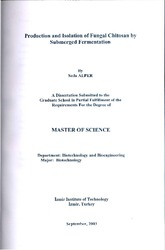Please use this identifier to cite or link to this item:
https://hdl.handle.net/11147/3645Full metadata record
| DC Field | Value | Language |
|---|---|---|
| dc.contributor.advisor | Harsa, Hayriye Şebnem | en |
| dc.contributor.author | Alper, Seda | - |
| dc.date.accessioned | 2014-07-22T13:52:01Z | - |
| dc.date.available | 2014-07-22T13:52:01Z | - |
| dc.date.issued | 2003 | en |
| dc.identifier.uri | http://hdl.handle.net/11147/3645 | - |
| dc.description | Thesis (Master)--İzmir Institute of Technology, Biotechnology and Bioengineering, İzmir, 2003 | en |
| dc.description | Includes bibliographical references (leaves: 50-52) | en |
| dc.description | Text in English;Abstract: Turkish and English | en |
| dc.description | xi, 74 leaves | en |
| dc.description.abstract | Chitosan is the N-deacetylated derivative of chitin which is the supporting material of crustaceans and insects. Chitosan together with chitin are recommended as suitable functional materials because of their excellent biocompatibility, biodegradability, non-toxicity and adsorption properties and can be used in agriculture, biotechnology and food industry. Although chitosan is produced by chemical deacetylation of chitin molecule, it is also a natural component of cell walls of fungi belonging to Zygomycetes and can be produced by extraction from fungus cell walls. Fungi are thus the promising alternative sources of chitosan. Fungi can be manipulated to give chitosan of more consistent and desired physico-chemical properties compared to chitosan obtained from crustacean sources. In this study, Absidia spp, Aspergillus niger, Rhizopus arrhizus, Cunnighamella elegans, and Mucor rouxii were examined for biomass growth. At first, all five species were grown on synthetic medium at 28 C, 180 rpm in shake-flask incubator. Mucorrouxii which gave the maximum biomass concentration was also grown on molasses. The maximum biomass concentration of Mucor rouxii was found to be higher than that of synthetic medium. The best growth conditions obtained were 4% sucrose, 0.2% yeast extract, 1% peptone and 106 spores in 40 ml. The mycelia harvested at late exponential phase was treated with alkali to remove proteins and chitosan was extracted from cell wall by using acetic acid. The yield of extractable chitosan obtained from cell wall of Mucor rouxii was 2500 mg / l and it is almost 20 % of biomass and approximately 35 % of alkali insoluble fraction. | en |
| dc.language.iso | en | en_US |
| dc.publisher | Izmir Institute of Technology | en_US |
| dc.rights | info:eu-repo/semantics/openAccess | en_US |
| dc.subject.lcc | TP248.65.C55 A47 2003 | en |
| dc.subject.lcsh | Chitin--Biotechnology | en |
| dc.subject.lcsh | Chitosan | en |
| dc.subject.lcsh | Biosynthesis | en |
| dc.subject.lcsh | Fungi--Biotechnology | en |
| dc.subject.lcsh | Biotechnological microorganisms--Isolation | en |
| dc.title | Production and isolation of fungal chitosan by submerged fermentation | en_US |
| dc.type | Master Thesis | en_US |
| dc.institutionauthor | Alper, Seda | - |
| dc.department | Thesis (Master)--İzmir Institute of Technology, Bioengineering | en_US |
| dc.relation.publicationcategory | Tez | en_US |
| item.languageiso639-1 | en | - |
| item.fulltext | With Fulltext | - |
| item.openairecristype | http://purl.org/coar/resource_type/c_18cf | - |
| item.openairetype | Master Thesis | - |
| item.grantfulltext | open | - |
| item.cerifentitytype | Publications | - |
| Appears in Collections: | Master Degree / Yüksek Lisans Tezleri | |
Files in This Item:
| File | Description | Size | Format | |
|---|---|---|---|---|
| T000249.pdf | MasterThesis | 5.59 MB | Adobe PDF |  View/Open |
CORE Recommender
Page view(s)
100
checked on Jul 22, 2024
Download(s)
146
checked on Jul 22, 2024
Google ScholarTM
Check
Items in GCRIS Repository are protected by copyright, with all rights reserved, unless otherwise indicated.